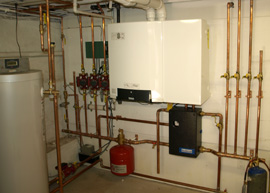Green Solutions

Take responsibility for your home or business. Fix leaks and take a good look at how much water is being used. Go room to room and use the following information to make smart, green changes.

Bathrooms
Toilets
Fix the leaks
- A leaking or "running" toilet can waste 200 gallons of water a day. That's 73,000 gallons a year, or enough to fill four in-ground swimming pools!
- Roto-Rooter can fix any leaking toilet but if you're a do-it-yourselfer, try replacing the flapper valve. This will fix most toilet leaks.
- Test your toilet for silent leaks by dropping a few drops of red food coloring in the tank. Wait fifteen minutes. If the water in the bowl has turned red, you have a leak.
Update and Save
- Prior to the 1950s, most U.S. toilets used about seven gallons per flush. By 1970, new toilets used about five gallons. The 1980s ushered in 3.5 gallon toilets. By 1993, 1.6 gallon toilets became the standard. Now many states and municipalities favor 1.28 gallon toilets.
- If your toilet was made before 1993, you are flushing money down the drain and using at least 3.5 gallons with every flush. Let Roto-Rooter replace your old toilet with a modern high-efficiency 1.28 gallon toilet. You'll start saving immediately, up to $2,000 in water costs over the lifetime of the toilet.
 Dual-Flush Retrofit
Dual-Flush Retrofit
- Roto-Rooter can convert most any residential or commercial toilet into a dual-flush toilet for a fraction of the cost of a new dual-flush toilet. Users choose a reduced flush for liquids or a full-power flush for solids. You'll start saving immediately because you'll use less water and will see a reduction in your sewer bill by generating less waste water.
Shower / Bathtubs
Low Flow Shower Head
 Take showers instead of baths. The average shower uses only one-third as much water as a bath.
Take showers instead of baths. The average shower uses only one-third as much water as a bath.- Change your shower head. Conventional shower heads use 3 to 4 gallons of water per minute. Low-flow models use 1 to 2.2 gallons per minute.
- Switching from a 3.5 gallons per minute (GPM) shower head to a 1.85 GPM head will save more than 6,000 gallons of water per year in the average shower.
- How much water does your shower use? Place a one-gallon bucket in your shower and count how many seconds it takes to fill with the shower running at full pressure. Now divide 60 by the number of seconds it took to fill the bucket. For example: 30 seconds = 2 GPM, 20 seconds = 3 GPM, 15 seconds = 4 GPM.
- If your shower uses 4 gallons per minute and you take a ten minute shower each day, that's 40 gallons per shower and 14,600 gallons per year! That's as much water as many in-ground swimming pools hold. Now imagine how much water a family of four uses each year just to shower!
 Sinks / Faucets
Sinks / Faucets
- Don't let the water run while shaving or brushing teeth.
- Check for leaks! Most leaky faucets can be repaired. If a faucet leaks one drop per second, it wastes 3,000 gallons of water per year!
- Replace your old faucet with a new one. Old faucets use up to 3.5 gallons per minute. New EPA WaterSense faucets use just 1.5 GPM.
- If you can't afford a new faucet, install an efficient aerator on your existing faucet and restrict water flow to 1.5 GPM or as low as 1/2 gallon per minute. Aerators are inexpensive and they make a big difference in water usage.
Touch-less Faucets
You've seen them in public restrooms but did you know that the top manufacturers now make touch-less faucets for residential bathrooms? Admittedly, they're expensive, but they will save a lot of water. Like any new technology, they will become less expensive in due time.
 Kitchen
Kitchen
- Don't leave the water running in the sink when washing dishes by hand.
- Use a scrub brush instead of relying on water pressure to remove stubborn food debris.
- Put dishes in a rack and rinse them all at once instead of individually.
- Only run the dishwasher when it is full of dishes.
- If waiting for tap water to get hot or cold, capture the water in a pitcher and use it to water house plants or to operate the garbage disposal.
- When washing hands, turn the water off while lathering then turn it back on to rinse.
- Don't defrost food under running water.
- Repair dripping faucets! They're costing you money and a faucet dripping once per second wastes 3,000 gallons per year!
- Garbage disposals require lots of water. Consider using it less by scraping plates into a garbage can.
 Laundry Room
Laundry Room
- Only run the washing machine when it has a full load.
- Make sure your laundry sink has an aerator on the spout. It limits water flow and saves you water and money.
- Inspect washing machine hoses for signs of wear. Roto-Rooter recommends replacing rubber hoses with stainless steel braided hoses. They last longer and are resistant to leaks and cracks.
- Consider replacing a worn out washing machine with a more efficient front-load model that uses a lot less water and energy to do the job.
Basement / Water Heater Closet
 Adjust water heater temperature to 125 degrees Fahrenheit, the optimum setting for a reliable supply of hot water and energy efficiency. It also reduces the risk of scalding.
Adjust water heater temperature to 125 degrees Fahrenheit, the optimum setting for a reliable supply of hot water and energy efficiency. It also reduces the risk of scalding.- If your water heater is more than 10 years old, consider replacing it with a new, more efficient model. Most conventional electric and gas water heaters have an 11-year life expectancy.
- Consider a heavily insulated, environmentally-friendly "heat pump" water heater that rivals tankless heaters in energy efficiency.
- See if a tankless, on-demand water heater is a good fit for you. These units heat water only as it is needed without continuously heating a large water tank.
- Roto-Rooter can install any water heater you want. We can deliver and install it for you, or you can purchase one and hire us to install it. We'll haul away your old one and make sure it is recycled and kept out of the landfill.*
* Recycling service not yet available in all locations.
 Outside
Outside
- Check your water meter before and after a two-hour period when no water is being used at your home. If the meter registers any water usage at all, you've got at least one leak, probably more.
- Pay attention to your water meter and your monthly water bill. A family of four shouldn't use more than 12,000 gallons of water per month. If the usage is much higher than that, the house probably has some serious leaks.
- Be sensible when watering the lawn. Reduce water evaporation by watering early in the morning or late in the evening.
- Make sure your sprinklers aren't watering patios, driveways and streets.
- If washing a car outside, put an automatic shut-off nozzle on your hose or use a professional car wash that recycles its water.
- Use a broom or a leaf blower to clean sidewalks and driveways, not a water hose.
- Repair swimming pool leaks and cover your pool to reduce water evaporation.
- Inspect outside faucets and hose connections for leaks. A leaking hose bib creates a greater risk of freezing and fracturing pipes during cold weather.
- Capture rainwater for re-use in the garden by installing rain collection barrels beneath roof gutter downspouts.
 Sewer
Sewer
- If your sewer is leaching raw sewage into the soil, it could potentially cause ground water contamination and other environmental hazards. If your sewer pipes aren't made from PVC / plastic, chances are, they could be leaking. If you've ever had tree roots invade your sewer line, then the pipe has voids that could allow sewage to leach into the surrounding soil.
- Roto-Rooter can inspect your sewer with a digital in-line video camera and tell you whether your sewer line is leaking. Your Roto-Rooter service technician will also provide repair and replacement options.
Loading customer reviews...